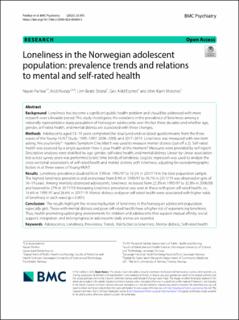| dc.description.abstract | Background
Loneliness has become a significant public health problem and should be addressed with more research over a broader period. This study investigates the variations in the prevalence of loneliness among a nationally representative study population of Norwegian adolescents over the last three decades and whether age, gender, self-rated health, and mental distress are associated with these changes.
Methods
Adolescents aged 13–19 years completed the structured and validated questionnaires from the three waves of the Young-HUNT Study: 1995–1997, 2006–2008, and 2017–2019. Loneliness was measured with one item asking, ‘Are you lonely?’. Hopkins Symptom Checklist-5 was used to measure mental distress (cut-off ≥ 2). Self-rated health was assessed by a single question ‘How is your health at the moment?’ Measures were provided by self-report. Descriptive analyses were stratified by age, gender, self-rated health, and mental distress. Linear-by-Linear association test across survey years was performed to test time trends of loneliness. Logistic regression was used to analyze the cross-sectional associations of self-rated health and mental distress with loneliness, adjusting for sociodemographic factors in all three waves of Young-HUNT.
Results
Loneliness prevalence doubled from 5.9% in 1995/97 to 10.2% in 2017/19 in the total population sample. The highest loneliness prevalence and an increase from 8.9% in 1995/97 to 16.7% in 2017/19 was observed in girls of 16–19 years. Among mentally distressed adolescents, loneliness increased from 22.3% in 1995/97 to 32.8% in 2006/08 and lowered to 27% in 2017/19. Increasing loneliness prevalence was seen in those with poor self-rated health, i.e., 14.6% in 1995-97 and 26.6% in 2017-19. Mental distress and poor self-rated health were associated with higher odds of loneliness in each wave (p < 0.001).
Conclusion
The results highlight the increasing burden of loneliness in the Norwegian adolescent population, especially girls. Those with mental distress and poor self-rated health have a higher risk of experiencing loneliness. Thus, health-promoting upbringing environments for children and adolescents that support mutual affinity, social support, integration, and belongingness in adolescents’ daily arenas are essential. | en_US |

